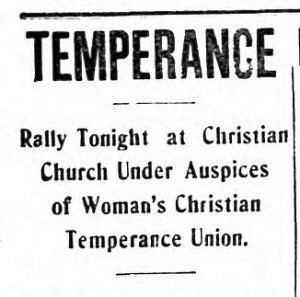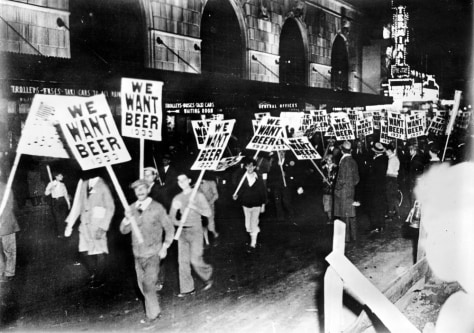Bonnie Lioce
The beginning of prohibition came at one of the most difficult times to control the people of the United States. World War II had just ended and the people wanted to celebrate as they came home to their families. Women had just won the right to vote. As people became more and more accustomed to alcohol and their tolerance levels rose, the damage alcohol does went unnoticed and that was when people started getting hurt by their actions and the people around them. Some of the accidents were so terrible that people started calling alcohol “the Devil’s brew” because they thought it was evil and blamed it for all their problems.
 |
| This is an example of prohibition propaganda that was posted through out cities in hope of support. |
Many people do not understand both sides of prohibition. The people against prohibition wanted to reduce drinking by eliminating the businesses that manufactured, distributed, and sold alcoholic beverages. The advocators of prohibition were motivated because alcohol was destroying families and taking the lives of the workers. Alcohol gives a human the courage to do and say things they would not say when they are sober. This lead to families breaking apart because the men were constantly drunk and abusing their families or cheating on their wives. This caused numerous amounts of problems because supporters were mainly religious people. Alcohol was more common than water for workers. Their employers gave them glasses of liquor on breaks, which led to drunken workers in the factories who got hurt or died because they were not in a suitable state to work. These motivations caused the formation of groups like the Anti-Saloon League and the Women’s Christian Temperance Union.
 |
| Citizens in support of prohibition often rioted or protested through out the streets of cities. |
Led by Frances E. Willard, the Women’s Christian Temperance Union worked tirelessly to banish alcohol. At the 1884 Republican National Convention, Frances said, “I come on behalf of millions of women… to ask that the guarantees and safeguards of law shall be stripped form the saloons of my country…and that the land we love may at once and forever go out of partnership with the liquor traffic”. The women’s groups would stop at saloons and ask the owners to shut down their businesses. Other times, the women would take charge and destroy the bars by smashing kegs and breaking all the liquor bottles on the table so the alcohol could not be drank. The female support of prohibition was influenced by their lives at home and the belief that drunkenness was ungodly. One famous woman, Carry Nation, is known for carrying a hatchet and bible with her wherever she went because she was “divinely inspired to destroy saloons and usher in temperance”(Rebman).
 |
| The women's groups firmly believed alcohol was horrible for their marriages and families. |
Prohibition ended up making people want to bend and break the law in any way possible. This was the complete opposite of the purpose of Prohibition because it spurred the creation of speakeasies and bootlegging. Earning profits became harder and harder for saloonkeepers so they began to introduce gambling and prostitution into their establishments as another way to get money. This increase in illegal production and sale of liquor was accompanied by a rise in gang violence and crimes in the cities. People were using bathtubs and sinks to brew their own alcohol and the client lists of druggists, people allowed to dispense medicinal quantities of alcohol, were skyrocketing. Although prohibition made most people uneasy, they worked together to make rum-running a successful business. This was trading and selling alcohol over water. Criminals, lawyers, government officials and other citizens saw prohibition as a way of getting rich because people were willing to buy alcohol for ridiculous amounts of money illegally.
 |
| People would gather in speakeasies during prohibition to drink alcohol even though it was illegal. |
The supporters of prohibition saw how badly alcohol affected an individual and why it should be banished. They believed getting rid of alcohol would cure the countries problems, keep people from spending paychecks at saloons, and decrease the number of losses during labor. In support of prohibition was the National Safety Council, which was made up of middle class citizens, businessmen, and crusading women who believed success depended on convincing the working class that Prohibition would benefit their lives. An example of a businessman who supported the prohibition movement was Henry Ford. He said he would be through with manufacturing if booze came back because it was so dangerous for his workers. This loss in the economy would take away jobs and money from families.
 |
| Henry Ford was one of the prominent business men in support of prohibition because it would benefit the quality of labor in his factories. |
Through the many efforts of the women’s groups and supporters of prohibition, the 18th amendment was ratified in January 1919. The amendment took away the rights for every citizen to buy or sell alcoholic drinks. Another way of saying that is banned the manufacture, transportation, and sale of intoxicating beverages. Prohibition lasted thirteen years until the 21st amendment was passed, repealing the 18th amendment and alcohol was legal once more. Even though the ban on alcohol ended, many people believed prohibition “worked” because the consumption of alcohol declined dramatically in the thirteen years it was enforced. In the 1920’s, the consumption of alcohol was thirty percent of the prohibition level. By the end of the movement, the consumption levels increased dramatically as the illegal supplies of liquor increased. New generations of Americans who disregarded the law contributed to the increase in consumption. This movement was considered progressive because the government was able to decrease the amount of alcohol consumed for a long enough time that the people decreased the amount of alcohol they drank.
 |
| Cities were filled with citizens celebrating the end of prohibition after the 21st amendment was passed. |
Works Cited
Rebman, Renée C. Prohibition. San Diego: Lucent, 1999. Print. This book provides me with information about the roots of prohibition and why it started. It told me about the role women had in the beginning of prohibition, that I did not know of before.
Blumenthal, Karen, and Jay Colvin. Bootleg: Murder, Moonshine, and the Lawless Years of Prohibition. New York: Roaring Brook, 2011. Print. This book gave me information on bootlegging and Morris Shepard, who played a large part in prohibition because he despised liquor and saloons that sold it. It also told me about the murders and other crimes prohibition caused.
Behr, Edward. Prohibition: Thirteen Years That Changed America. New York: Arcade Pub., 1996. Print. This book told me that the Saint Valentines Day Massacre occurred because of the problems prohibition caused and how the public continued to drink intoxicating liquors and break the law.
Brown, L. Ames. "Prohibition." JSTOR. University of Northern Iowa, n.d. Web. 12 Feb. 2015. <http://www.jstor.org/stable/25108648?Search=yes&resultItemClick=true&searchText=prohibition&searchUri=%2Faction%2FdoBasicSearch%3FQuery%3Dprohibition%26amp%3Bacc%3Don%26amp%3Bwc%3Don%26amp%3Bfc%3Doff%26amp%3Bgroup%3Dnone&seq=3#page_scan_tab_contents>. This article by the North American Review gave me the point of view of an observer of prohibition. He looked at both sides of prohibition and talked about the reasons for peoples actions. It is also published in 1915 which helped put the feeling of prohibition into my mind so I could understand what the time period was like.
Tomkins, Floyd W. "Prohibition." Jstor. Sage Publications, Inc. in Association with the American Academy of Political and Social Science, n.d. Web. 12 Feb. 2015. <http%3A%2F%2Fwww.jstor.org%2Fstable%2F1014989%3FSearch%3Dyes%26resultItemClick%3Dtrue%26searchText%3Dprohibition%26searchUri%3D%252Faction%252FdoBasicResults%253FQuery%253Dprohibition%2526amp%253Bacc%253Don%2526amp%253Bwc%253Don%2526amp%253Bfc%253Doff%2526amp%253Bgroup%253Dnone%2526amp%253Bvf%253Djo%26seq%3D3%23page_scan_tab_contents>. This article is told after prohibition had ended and looks at whether or not is was effective and how it was enforced during the 13 years the law was in effect. It has multiple quotes from important authoritative figures like President Harding and Charles Thaddeus Terry, a leading New York attorney during prohibition.















.jpg)



